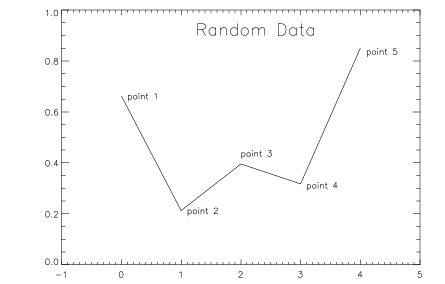XYOUTS Procedure
Draws
Usage
XYOUTS, x, y, string
Input Parameters
x, y—Specifies the column, x and the row, y at which the output string should start. Both x and y are normally taken to be in data coordinates; however, the Device and Normal keywords can be used to change this unit.
Output Parameters
string—The scalar string containing the text that is to be output to the display surface. If not of string type, it is converted prior to use.
Keywords
Background—Fills the area behind the text with a specified color. The default, –1, indicates no fill.
Additional XYOUTS keywords are listed below. For a description of each keyword, see Graphics and Plotting Keywords.
| Alignment | Color | Normal | Text_Axes |
| Channel | Data | Orientation | Width |
| Charsize | Device | PClip | Z |
| Charthick | Font | Size | |
| Clip | Noclip | T3d |
Discussion
XYOUTS is machine-dependent when you are using hardware fonts. This means that on two different machines, the same commands may produce text that does not appear the same. To guarantee similar appearance, use software fonts.
DEVICE, font='-adobe-courier-medium-r-normal--14-*'
Example
In this example, XYOUTS is used to label a plot of random data. Procedure XYOUTS also is used to place a title on the plot. Text placement is relative to the x and y coordinates of the plot, which is the default for XYOUTS. Note that the CURSOR procedure was used to determine the proper coordinates at which to place labels. This example uses PV‑WAVE IMSL Statistics Toolkit procedure RANDOMOPT. The results are shown Plot Labeling.
; Create a 5-element vector of random data. STAT_INIT RANDOMOPT, Set=1234567 x = RANDOM(5) ; Plot and label the data. PLOT, x, XRange=[-0.5, 4.5] XYOUTS, 0.1, 0.65, "Point 1" XYOUTS, 1.1, 0.20, "Point 2" XYOUTS, 2.0, 0.425, "Point 3" XYOUTS, 3.1, 0.30, "Point 4" XYOUTS, 4.1, 0.825, "Point 5" ; Place a title on the plot. Make the title twice the default ; character size using the Charsize keyword. XYOUTS, 1.25, 0.9, "Random Data", Charsize=2
|
|
See Also
For more information on using XYOUTS to annotate plots, see the PV‑WAVE User Guide.
